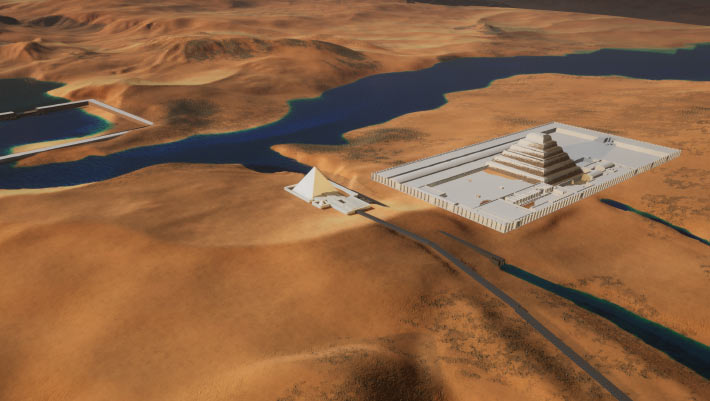The Pyramid of Djoser, also known as the Step Pyramid, is considered the oldest of the seven monumental pyramids built about 4,500 years ago.
Map of the Saqqara plateau showing the water course from the Gisr el-Mudir dam (left) to the water treatment facility near Djoser pyramid. The water is then transferred to the pyramid’s network of pipes to power the hydraulic elevator. Image credit: Landreau et al., doi: 10.1371/journal.pone.0306690.
The Pyramid of Djoser, built at Saqqara in Egypt around 2680 BCE, is considered a significant milestone in monumental architecture.
It is the first to disclose two crucial innovations: a pyramid shape for the Pharaoh’s tomb and the exclusive use of fully dressed stones for masonry.
In practice, it is also revolutionary in the ability to extract and raise stones by millions before stacking them with precision.
Djoser’s complex visible achievements are such that its architect, Vizier, and Great Priest of Ra, Imhotep, was deified by the New Kingdom.
In a new transdisciplinary analysis, Dr. Xavier Landreau from CEA Paleotechnic Institute and colleagues discovered that a hydraulic lift may have been used to build the pyramid.
Based on their mapping of the nearby watersheds, the authors found that one of the unexplained massive Saqqara structures, the Gisr el-Mudir enclosure, has the features of a check dam with the intent to trap sediment and water.
In addition, a series of compartments dug into the ground outside of the pyramid may have served as a water treatment facility, allowing sediment to settle as water passed through each subsequent compartment.
Water may then have been able to flow into the pyramid shafts themselves, where the force of its rise could help carry the building stones.
Further research is still needed to understand how water might have flowed through the shafts, as well as how much water was available on the landscape at that point in Earth’s history.
But the archaeologists suggest that even as other building methods like ramps were probably also used to help build the pyramid, a hydraulic lift system could have been used to support the building process when there was enough water.
“We identified that the Step Pyramid’s internal architecture is consistent with a hydraulic elevation mechanism never reported before,” they said.
“The ancient architects may have raised the stones from the pyramid center in a volcano fashion using the sediment-free water from the Dry Moat’s south section.”
“Ancient Egyptians are famous for their pioneering and mastery of hydraulics through canals for irrigation purposes and barges to transport huge stones.”
“This work opens a new line of research: the use of hydraulic force to erect the massive structures built by Pharaohs.”
The study appears online in the journal PLoS ONE.
_____
X. Landreau et al. 2024. On the possible use of hydraulic force to assist with building the Step Pyramid of Saqqara. PLoS ONE 19 (8): e0306690; doi: 10.1371/journal.pone.0306690

